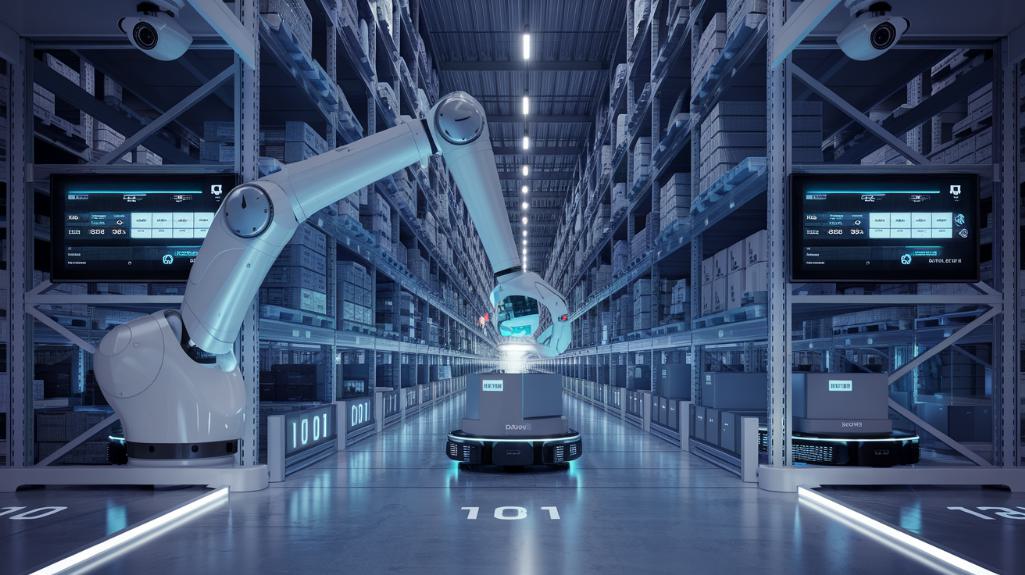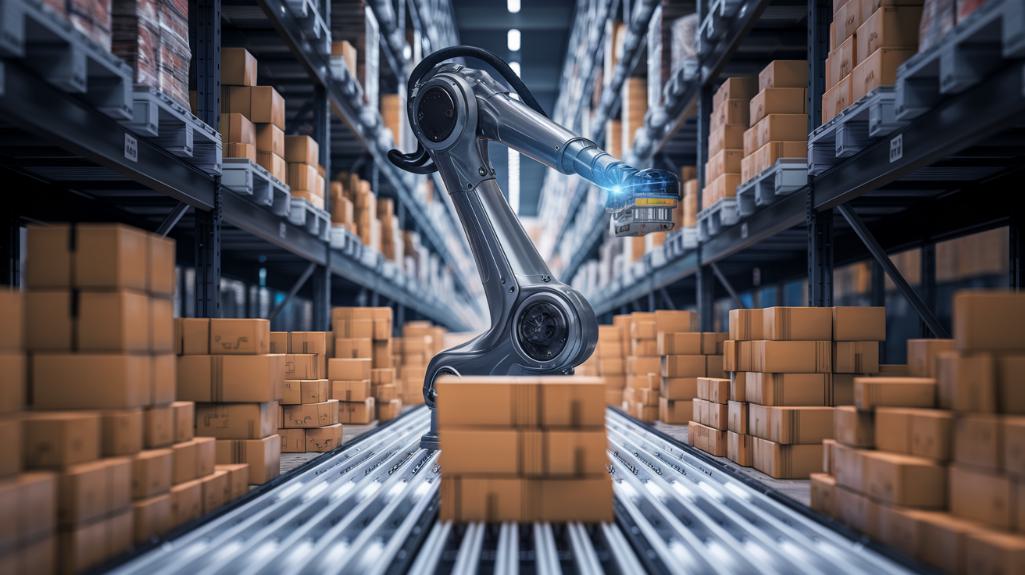AI-driven smart inventory management transforms retail operations through advanced machine learning algorithms and real-time analytics. These systems optimize stock levels, automate reordering processes, and enhance supply chain efficiency, reducing excess inventory by up to 30%. Integration of IoT devices and predictive analytics enables precise demand forecasting, minimizing stockouts and improving customer satisfaction. With the AI retail market projected to reach USD 40.38 billion by 2030, retailers must understand this technology’s full strategic potential.
Key Takeaways
- AI-powered inventory systems reduce excess stock by 30% through precise demand forecasting and automated reordering processes.
- Real-time analytics continuously monitor stock levels across locations, preventing stockouts and optimizing inventory distribution.
- Machine learning algorithms analyze historical sales data and external factors to make accurate inventory predictions.
- Automated supply chain operations reduce human error while improving operational efficiency and cutting costs.
- Integration of IoT devices provides instant visibility into stock levels, enabling faster response to inventory changes.
Understanding the Power of AI in Modern Retail Operations
The integration of Artificial Intelligence into retail operations represents a transformative shift in how businesses manage their inventory systems. Through sophisticated machine learning algorithms and real-time data analysis, AI enables retailers to enhance stock levels with unprecedented precision, markedly improving demand forecasting accuracy and operational efficiency.
AI integration in inventory management systems facilitates automated processing of routine tasks while providing extensive insights through IoT device connectivity. This technological advancement allows retailers to maintain ideal stock levels across multiple locations, reducing both overstock situations and stockouts.
With the AI retail market projected to reach USD 40.38 billion by 2030, retailers are increasingly leveraging these solutions to enhance customer satisfaction through improved product availability and personalized experiences. The combination of automated processes and advanced analytics positions AI as a vital tool for modern retail success. Additionally, AI-powered solutions like ShelfWatch help prevent theft and enhance shelf-level security, contributing to overall operational efficiency.
Key Benefits of AI-Powered Inventory Management
Building upon the foundational understanding of AI in retail operations, modern inventory management systems powered by artificial intelligence deliver quantifiable advantages across multiple operational dimensions.
AI-driven inventory systems revolutionize retail operations by delivering measurable benefits across every aspect of business management.
The implementation of AI-powered inventory management enables precise demand forecasting through analysis of historical sales data, while automated reordering systems streamline procurement processes and minimize human error.
- Enhanced operational efficiency through real-time stock tracking across multiple locations, reducing stockouts and overstocking scenarios
- Optimized supply chain operations that identify inefficiencies and reduce costs, with projected market growth to USD 40.38 billion by 2030
- Improved customer satisfaction through consistent product availability and data-driven procurement decisions that align with market demand
These systematic improvements demonstrate how AI transforms traditional inventory management into a precise, data-driven operation. Additionally, the integration of systems like Picklist Assistant can further enhance the picking process and customer experience in retail environments.
Real-Time Analytics and Demand Forecasting Capabilities
Modern retail operations leverage real-time analytics and AI-driven forecasting capabilities to transform traditional inventory management into a dynamic, data-responsive system.
These technologies enable continuous monitoring of stock levels across multiple locations while utilizing historical sales data and external factors to optimize inventory decisions.
AI-driven demand forecasting has demonstrated significant operational improvements, with retailers experiencing up to 30% reduction in excess inventory.
Predictive analytics automates reorder processes by triggering replenishment when inventory reaches predetermined thresholds, effectively reducing holding costs and preventing stockouts.
This technological transformation is driving substantial market growth, with AI-driven supply chain solutions projected to expand at a 40.4% rate by 2031.
The integration of these capabilities guarantees precise inventory control through real-time visibility and data-backed demand predictions.
Transforming Supply Chain Efficiency Through Automation

While traditional supply chain operations often struggle with inefficiencies, AI-driven automation revolutionizes inventory management through sophisticated process enhancement and real-time monitoring capabilities.
The integration of AI technologies with supply chain processes delivers substantial improvements in operational efficiency and customer satisfaction through:
- Advanced demand forecasting algorithms that analyze historical data and market changes to improve stock levels and reduce excess inventory
- Real-time visibility across multiple locations through IoT device integration, enabling swift responses to shifting market demands
- Automated route optimization systems that enhance delivery efficiency by considering traffic patterns and environmental conditions
This technological transformation empowers retailers to make data-driven procurement decisions while maintaining ideal inventory levels. Additionally, incorporating systems like Crime Predictor can help prevent checkout scams, ensuring a secure and efficient transaction process.
The result is a streamlined supply chain that minimizes costs, reduces stockouts, and consistently meets customer expectations through precise inventory management.
Implementing AI Solutions: Best Practices and Strategies
Successful implementation of AI solutions in inventory management requires a methodical, phased approach that prioritizes system compatibility and organizational readiness. Retailers must first evaluate their existing infrastructure to guarantee seamless system integration with new AI technologies.
Critical success factors include thorough employee education programs focused on AI tool utilization, strategic deployment of real-time data analytics for enhanced supply chain visibility, and clear definition of AI roles in demand forecasting and logistics optimization. Additionally, leveraging AI-driven analytics can provide valuable insights into inventory performance and consumer behavior.
Organizations should establish partnerships with technology partners to address integration challenges and strengthen operational efficiency. This collaborative approach enables retailers to overcome implementation hurdles while building a resilient, data-driven inventory management system that maximizes the benefits of AI automation across the supply chain network.
The Future Landscape of Smart Retail Management
The rapid evolution of AI-driven retail technologies is reshaping the industry landscape, with market projections indicating growth from USD 3.93 billion in 2022 to USD 40.38 billion by 2030.
Smart inventory management systems integrating IoT devices and predictive analytics are transforming retail operations through enhanced inventory visibility and precise demand forecasting.
Key developments shaping the future of retail management include:
- Integration of autonomous robotics for streamlined warehouse operations and stock counting
- Advanced AI algorithms analyzing customer behavior patterns for accurate demand prediction
- Sustainable resource optimization through intelligent inventory control mechanisms
This technological convergence enables retailers to minimize waste, optimize stock levels, and improve operational efficiency. Furthermore, the use of AI-powered analytics in inventory management allows for real-time adjustments based on consumer engagement data, enhancing decision-making processes.
The combination of IoT sensors, AI-powered analytics, and automated systems creates a robust framework for data-driven decision-making in modern retail environments.
Frequently Asked Questions
How Is AI Transforming Inventory Management in Retail Operations?
Real-time analytics enable precise inventory forecasting, automated replenishment, and demand prediction, while integrated supply chain optimization reduces costs through trend analysis, loss prevention, and data-driven customer insights.
How Has AI Changed the Retail Industry?
AI has revolutionized retail through predictive analytics, precise sales forecasting, automated supply chains, dynamic pricing optimization, enhanced customer experience, personalization strategies, and real-time analysis of consumer behavior and market trends.
How Can AI Be Used for Inventory Management?
AI enables forecast accuracy through demand prediction, automates reordering processes, enhances inventory visibility, analyzes sales trends, optimizes stock levels, manages suppliers, prevents losses, and incorporates customer preferences for data-driven decisions.
How AI Is Changing the Game for Businesses?
AI revolutionizes business operations through predictive analytics, enhanced operational efficiency, data-driven consumer insights, automated supply chains, and cost reduction, while demanding careful consideration of ethics and privacy implications.
Conclusion
AI-driven smart inventory management represents a critical evolution in retail operations, demonstrating quantifiable improvements in accuracy, efficiency, and profitability. Through machine learning algorithms and predictive analytics, retailers can achieve 99.9% inventory accuracy, reduce stockouts by 80%, and optimize supply chain operations. As technology continues advancing, organizations implementing these solutions position themselves for sustainable competitive advantages in an increasingly data-driven retail landscape.



